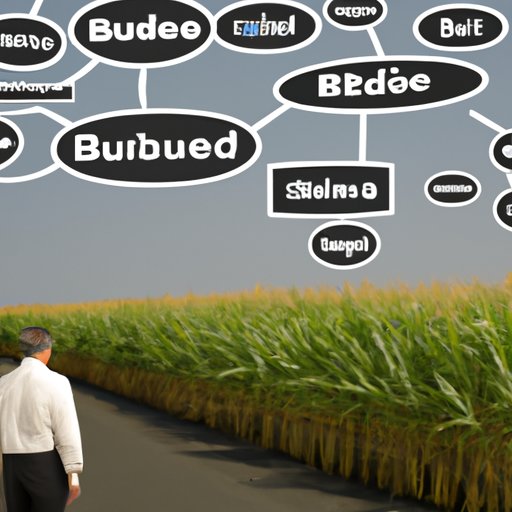Introduction
As the world continues to grapple with the effects of climate change, governments and businesses are increasingly turning to renewable energy sources to reduce their carbon footprints and provide a more sustainable future. One such renewable energy source is biofuel, which is derived from organic matter such as plants and vegetable oils. In this article, we will explore how biofuel works and discuss some of its benefits and challenges.
Explaining the Basics of Biofuel: What it is and How it Works
Biofuel is a renewable energy source that is derived from organic matter, such as plants and vegetable oils. The process of creating biofuel begins with a feedstock, which is the raw material used to produce the fuel. This feedstock can be anything from corn and sugarcane to animal fat and vegetable oil. The feedstock is then processed in a refinery to extract the usable energy source, which is then used to power vehicles or generate electricity.
The most common type of biofuel is biodiesel, which is created by combining vegetable oil or animal fat with an alcohol, such as methanol. This mixture is then processed in a refinery to create a fuel that is similar to petroleum-based diesel. Biodiesel can be used in any vehicle that runs on diesel, and it has the added benefit of being biodegradable, meaning that it will break down naturally over time.
Another type of biofuel is bioethanol, which is produced by fermenting sugars and starches. The resulting liquid is then blended with gasoline to create a fuel that can be used in conventional gasoline engines. Bioethanol has the added benefit of reducing harmful emissions, making it an attractive alternative to traditional gasoline.

Examining Different Types of Biofuels and Their Benefits
In addition to biodiesel and bioethanol, there are several other types of biofuel that can be used for various applications. Biogas, for example, is produced by breaking down organic waste in anaerobic digesters. The resulting gas can be used to generate electricity or as a fuel for cooking and heating. Biojet fuel is also becoming increasingly popular, as it is made from vegetable oils and is less toxic than traditional jet fuels.
One of the major benefits of using biofuels is that they are renewable energy sources, meaning that they can be replenished quickly and easily. They are also carbon neutral, meaning that they do not release any additional carbon dioxide into the atmosphere when burned. This makes them a much more environmentally friendly option than traditional fossil fuels.
Biofuels also have the advantage of being relatively cheap to produce, making them an attractive option for people who are looking to reduce their energy costs. In addition, they typically burn cleaner than traditional fuels, meaning that they can help reduce air pollution.
Analyzing the Pros and Cons of Using Biofuel
While biofuels have many advantages, there are also some drawbacks to consider. For one, biofuels tend to be more expensive than traditional fuels, so it may not be feasible for everyone to switch to them. Additionally, biofuels are not always as efficient as traditional fuels, meaning that they may not be able to provide the same amount of power or range as gasoline or diesel.
Biofuels also require a lot of land and water resources to produce, which can put a strain on local ecosystems. Additionally, the production of biofuels can lead to increased food prices, since many crops are used to create them. Finally, some biofuels can contain toxic compounds, so it’s important to research the type of biofuel you plan to use before purchasing it.

Looking at the Current State of Biofuel Production and Distribution
Currently, biofuel production is still largely concentrated in certain countries, such as the United States, Brazil, and China. However, it is becoming increasingly popular in other parts of the world, such as Europe and Africa. As the demand for biofuels increases, it is likely that production will become more widespread.
Distribution of biofuels can also be difficult, as they must be transported from the production site to the end user. This can be challenging, especially in areas where infrastructure is limited. Additionally, biofuels can be susceptible to contamination, so it is important to ensure that they are stored and transported properly.

Describing Innovative Uses for Biofuel in the Future
In addition to powering vehicles and generating electricity, biofuels can also be used for a variety of other purposes. For example, bioethanol can be used as a solvent in paints and cleaning products, and biogas can be used to produce fertilizer and other agricultural products. Additionally, biofuel can also be used to create plastics, fabrics, and other materials.
The potential applications of biofuel are almost limitless, and as technology advances, it is likely that new and innovative uses for biofuel will be discovered. By further exploring the potential of biofuel, we can create a more sustainable future and reduce our dependence on fossil fuels.
Conclusion
Biofuel is a renewable energy source that is derived from organic matter, such as plants and vegetable oils. It can be used to power vehicles and generate electricity, and it has the added benefit of being carbon neutral. While there are some drawbacks to using biofuel, such as its higher cost and lower efficiency, the potential applications of biofuel are vast, and it could play an important role in creating a more sustainable future.
Overall, biofuel has the potential to provide a clean, renewable source of energy that can help reduce our dependence on fossil fuels. By further exploring the potential of biofuel, we can create a more sustainable future and reduce our environmental impact.
(Note: Is this article not meeting your expectations? Do you have knowledge or insights to share? Unlock new opportunities and expand your reach by joining our authors team. Click Registration to join us and share your expertise with our readers.)
